L’intera regione della Toscana festeggia il 50 ° anniversario di quest’anno dell’ultimo terribile alluvione che ha colpito Firenze nella notte del 3/4 novembre 1966 e ha devastato la città, dalle case, edifici di secolari capolavori di opere d’arte. Ci sono mostre speciali per commemorare l’anniversario, nonché conferenze, processioni, visite e incontri delle persone che erano presenti 50 anni fa. Se si torna a Firenze dopo essere stato un “fango Angel”, visitatore o residente locale che desideri partecipare o saperne di più circa gli effetti del diluvio, abbiamo raccolto un elenco dei tanti eventi e mostre si può visitare a testimoniare la evento straordinario che devastò Firenze 50 anni fa. E ‘importante ricordare che Firenze non è stata l’unica città allagata in quel fatidico giorno: lungo tutto il corso del fiume, la distruzione seguita. Lo stesso giorno, il fiume Ombrone anche allagata e ha causato la distruzione di Grosseto e la Maremma. Così il giorno rimane un fatidico giorno nei ricordi di tutti i toscani allo stesso modo, al di là di Firenze.
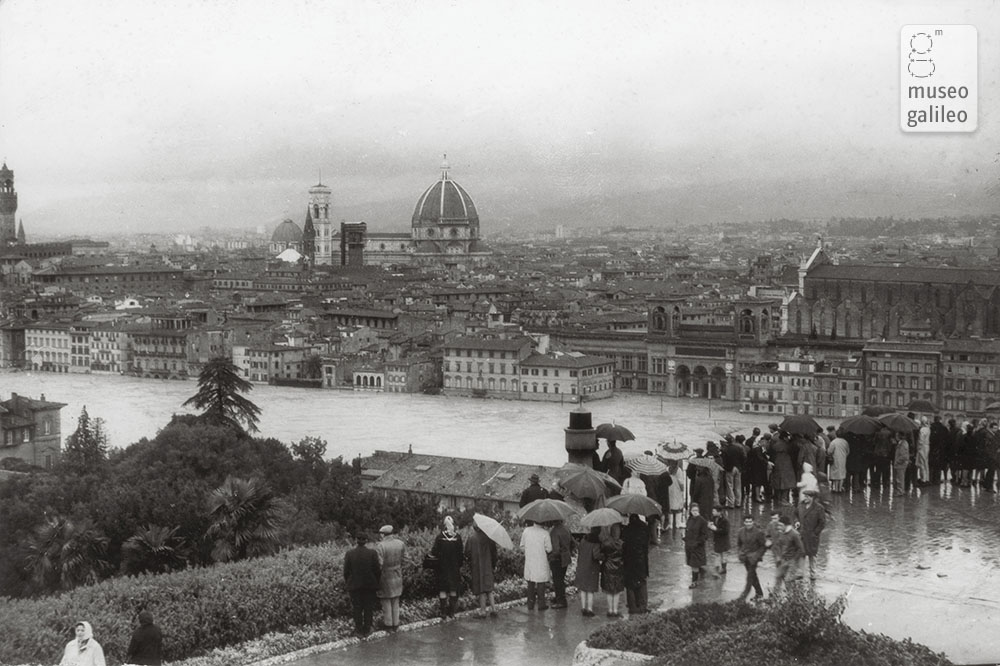
Il 4 novembre
L’alluvione ha colpito Firenze il 4 novembre 1966 in modo che le celebrazioni ufficiali della città si svolgerà in questa giornata e proseguire fino al 6 °.
Le celebrazioni ufficiali in questo giorno sono:
8.30 – celebrazione da parte delle forze armate in Piazza Unità d’Italia
9.00 – riunione speciale del consiglio comunale con gli “Angeli del fango” nel Salone dei Cinquecento di Palazzo Vecchio. La città vuole rendere omaggio ai volontari che sono venuti a Firenze nei giorni dopo l’alluvione di offrire la loro assistenza nella pulizia della città, contribuendo a salvare milioni di libri e documenti dagli archivi statali e salvare le opere pricelsss d’arte dal fango e sporcizia del diluvio. Hanno lavorato per giorni, settimane e anche mesi per aiutare Firenze emergere dalle macerie e devastazione del diluvio lasciato alle spalle.
In seguito, gli Angeli del fango stanno tenendo il loro incontro commemorativo up, che comprenderà testimonianze di Angeli del fango, nonché la proiezione del intervista a Franco Zeffirelli dalla RAI e il gioco di due brani composti per l’occasione dal maestro Giuseeppe Lazetta e orchestra.
La cerimonia dovrebbe concludersi entro 13:00. Gli eventi sono aperti a chiunque ma si ha bisogno per ottenere un badge prima: tra 2-04 Novembre, andare a Piazza dell’Unità 1 in cui la Regione Toscana offrirà kit di benvenuto al ritorno Angeli del fango, che possono anche essere utilizzati per visitare città musei gratis ed essere esclusi dal pagamento della tassa di soggiorno mentre siete a Firenze.
11.30 – Il Cardinale Arcivescovo Giuseppe Betori, anche lui steso un angelo del fango, celebrerà la Santa Messa in Santa Croce. Da lì, intorno a 1:00, una piccola processione sarà a capo di Ponte alle Grazie per depositare una corona floreale in Arno per commemorare le vittime del diluvio.
3.00 – ricollocazione di restauro dell’Ultima Cena di Vasari a Santa Croce, dove il presidente di Italia, Sergio Mattarella sarà presente.
5.00 – la cerimonia ufficiale commemorativa si terrà a Palazzo Vecchio Salone dei Cinquecento con il presidente d’Italia Mattarella e altri rappresentanti del governo. Volontari, forze armate soci e dei terzi che erano presenti nel 1966 saranno presenti.
6.30 – proiezione del documentario completo “Dopo il diluvio” nel Salone dei Cinquecento.
8.30 – una processione a lume di candela da Basilica di San Miniato al Monte fino a Piazza Santa Croce, in ricordo della processione che si è tenuta il 4 novembre del 1967, un anno dopo il diluvio. Tutti sono invitati a partecipare, da Angeli del fango per gli studenti. L’obiettivo della processione, in modo simbolico, è quello di “passare sopra” l’accusa di cura e amore per Firenze dalla vecchia generazione che era presente nel 1966 alla generazione di oggi.
9.00 – a partire dalle 21:00, si può sperimentare il video-mapping suggestivo sul Ponte Vecchio che mostra la storia del ponte con le foto dal Archivio Fotografico Locchi. La proiezione verrà eseguito ogni mezz’ora 07:00-11:00 ogni giorno fino a 19 novembre
5 novembre
Presentazione da parte della Regione Toscana e del Consiglio dei Ministri del piano “Arno Sicuro“, che mette in evidenza i lavori in corso e plannes per garantire la massima sicurezza lungo l’intera rive dell’Arno. In Palazzo Vecchio Salone dei Cinquecento.
6 novembre
L’intera giornata sarà dedicata ai volontari, con la regione che chiede il giorno per essere chiamata la “Giornata del Volontariato”. La giornata inizia alle 9.30 con il taglio del nastro rosso alla mostra dedicata al diluvio in Palazzo Medici Riccardi in via Cavour 2/4.
Alle 11.30, una conferenza al Teatro Verdi (Via Ghibellina 99) avrà luogo il “Protezione Civile e Volontari Oggi”, in cui la regione Toscana, Comune di Firenze e Dipartimento Nazionale della Protezione Civile interagirà con i rappresentanti di tutti i tipi di organizzazioni di volontariato.
Dalle 10 alle 11, a Palazzo Strozzi Sacrati (Piazza Duomo 19), il presidente della Regione Toscana Enrico Rossi metterà in evidenza su quanto è stato realizzato e ciò che deve ancora essere fatto per proteggere i cittadini dal rischio di inondazioni. Questo evento è riservato ai maggiori città delle città che corrono il rischio di inondazioni in Toscana.
Nel corso di questa giornata, è anche possibile visitare la “città della Protezione Civile“, che sarà allestito in Piazza Santa Croce, che metterà in evidenza il lavoro che la Protezione fa in materia di calamità naturali in tutta l’Italia tutta.
Al 16:00 presso il Cinema Odeon (Piazza Strozzi), è anche possibile vedere la proiezione di “Perché salvare Firenze?”, un documentario straordinario del 1968 che ha rivelato lo stato deplorevole delle difese anti-inondazione della città. Mostrando per la prima volta a Firenze, il documentario sarà presentato dal direttore, Roger Graef, se stesso. Il film contiene immagini uniche, e documenti inediti e testimonianze, tra cui una intervista di Indro Montanelli. In inglese con sottotitoli in italiano, biglietto d’ingresso 5 euro, dura circa un’ora.
Angeli del fango benvenuti dalla Città
Come accennato in precedenza, tutti gli Angeli del fango di ritorno a Firenze riceveranno un piccolo segno di apprezzamento da parte della città di Firenze: ritirare il kit di benvenuto in Piazza dell’Unità 1 novembre 2, 3 e 4, che includerà un badge in modo che si può partecipare a tutti gli eventi in Palazzo Vecchio, così come utilizzare il sistema di autobus ATAF e visitare i musei della città gratuitamente e sono esenti dal pagamento della tassa del turismo della città mentre siete a Firenze. Circa 800 Angeli del fango si prevede di tornare a Firenze nel corso di questo fine settimana speciale.
Esposizioni
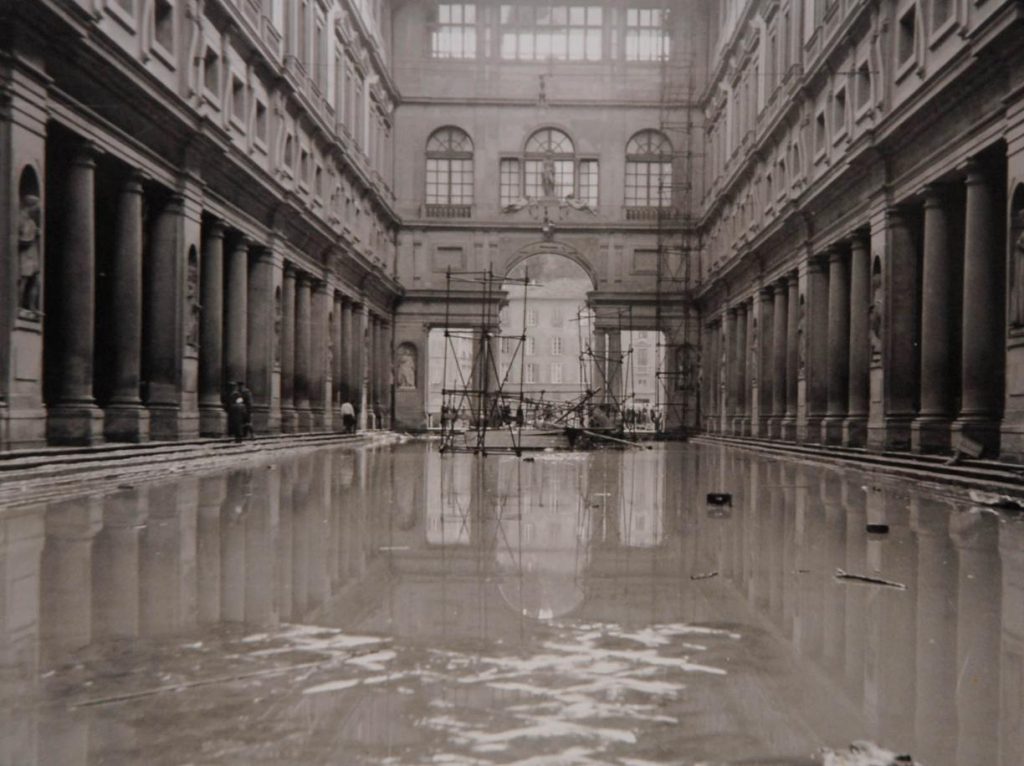
Fotografie agli Uffizi
La Galleria degli Uffizi organizzerà anche una piccola mostra temporanea che raccoglie fotografie di personale degli Uffizi nel 1966 della galleria degli Uffizi allagata, sia dentro che fuori. Solo un piccolo, modo in più per ricordare il disastro l’alluvione ha sul museo stesso.
Palazzo Medici Riccardi
Dalle 18:00 del 3 novembre fino al 30 novembre (apertura 10:00-06:00, gratuito), la mostra “Arno66” si apre nella Galleria delle Carozze per ricordare l’alluvione del 1966, con fotografie e video delle stesse macchie nel 1966 e oggi. Una narrazione attraverso le immagini di quanto è stato fatto e ciò che è cambiato negli ultimi 50 anni per proteggere la regione dalle alluvioni future.
All’interno del Palazzo, un’altra mostra dedicata al diluvio presenterà le opere d’arte che sono state distrutte durante l’alluvione, e che sono state restaurate. Dal 31 ottobre al 5 marzo 2017. Aperto 09:00-07:00.
Beyond Borders – Novecento Museum
Also opening on Thursday November 3rd at 7pm, the exhibit at the Novecento museum will showcase all of the works (documents and paintings) donated to the city of Florence by artists of the time as a sign of solidarity after the flood, to replenish the city’s heritage of art considering what was lost. The exhibit will run until January 8, 2017 and is included in the museum ticket or separately.
The Flood in Pisa
From October 29th through January 1st, 2017, head to Palazzo Blu in Pisa to see the photographic exhibit of the effects of the Arno flood of 1966 down the river in Pisa, Pontedera, Santa Croce and Castelfranco. Free entry. Open Monday-Friday 10am-7pm and Saturday and Sunday 10am-8pm. For more details: http://www.palazzoblu.it/
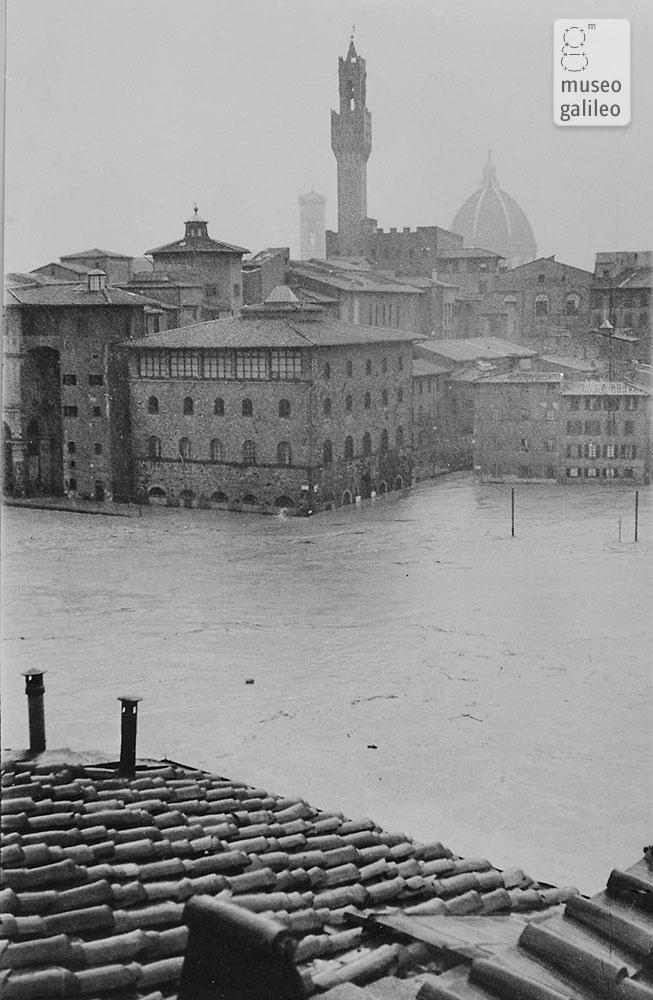
“Fishing in the Mud: The Museum and the Flood” – Galileo Museum
Open since June 20th and running until November 20th, the exhibit organized at the Galileo Museum recalls the historic event of the 1966 flood which submerged the basement and ground floors of the museum (then called the Institute and Museum of the History of Science) and caused extensive damage to the collections. Fifty years later, the exhibit documents the event, focusing on the dramatic effects the institute suffered and highlighting the salvage work and subsequent restoration of its antique scientific instruments. The success of the efforts can mostly be attributed to its then director, Maria Luisa Righini Bonelli who transformed the catastrophe into an opportunity to expand the museum’s exhibition space, modernize the criteria for the conservation and display of its valuable collections and consolidate its network of ties with important scholars and institutions around the world. The exhibition includes photographs of the museum before and after the flood, books that still show the flood damage, and others who have only recently been restored. For more details, check out: http://mostre.museogalileo.it/pescarenelfango/
“Notturno Fluviale: The bridges across the Arno from Falterona to Pisa”
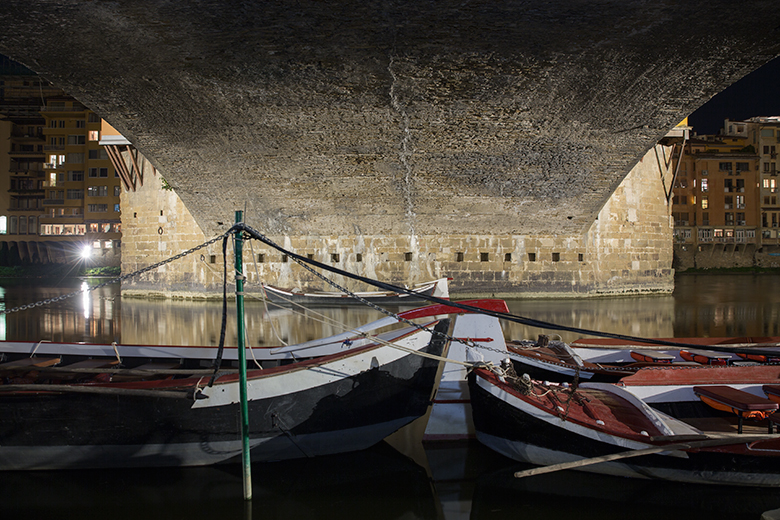
This is a contemporary photographic project by Marco Castelli to set out to photograph all of the bridges along the Arno at night, to showcase man’s attempt to live and control the river. It documents as well as portrays surreal settings, at water level and from a new perspective, under the bridges. Free entrance, November 2-7, 11am-8pm at the OnArt Gallery (via della Pergola, 57/61r, Florence).
Photographs of the Flood in Florence
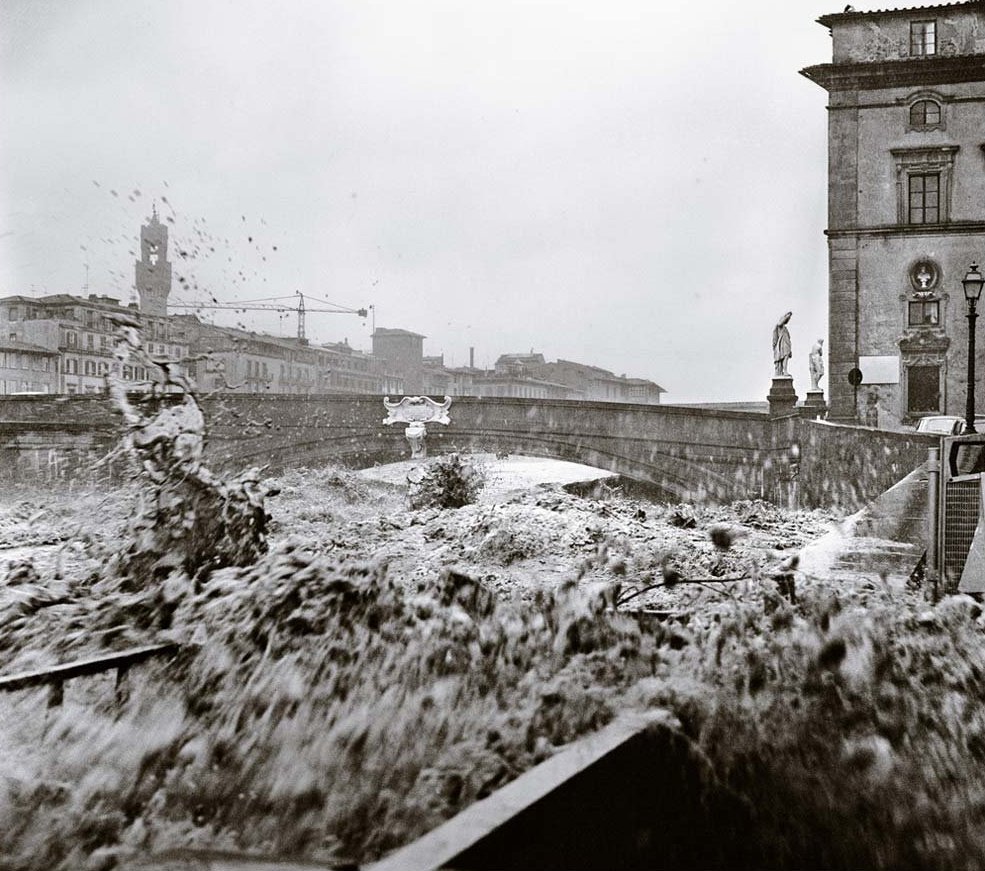
Balthazar Korab, one of the most famous and celebrated photographers from the last century, was one of the first photo-reporters in Florence after the flood. Many of the photos you may have seen of Florence after the flood published in newspapers around the world were his. Today, 16 photos from 1966 is on show at Tathys Gallery (Via dei Vellutini, 17r, Florence) from October 27 until November 26. Hours are Monday-Friday 9am-1pm and 2-7pm, Saturdays 3-7pm.
“Arno: Source of Prosperity, Source of Destruction” – State Archive in Florence
The subtitle for the exhibit is “History of the river and of the territory within the archives letters“. Open until February 4, 2017 (Monday-Friday 9am-5pm and Saturdays 9am-1pm), the exhibit focuses on the history of the river which includes documents, maps, drawings, original projects, photographs, works of art and even a boat used on the Arno on November 4th, 1966. While the focus is on the Arno and the flood of 1966, the exhibit also documents even more recent floods across Tuscany that have compromised the historical documents and patrimony of the region, highlighting the efforts to restore documents to recuperate items lost by flood waters.
National Library – “Arno 66: A Time Machine”
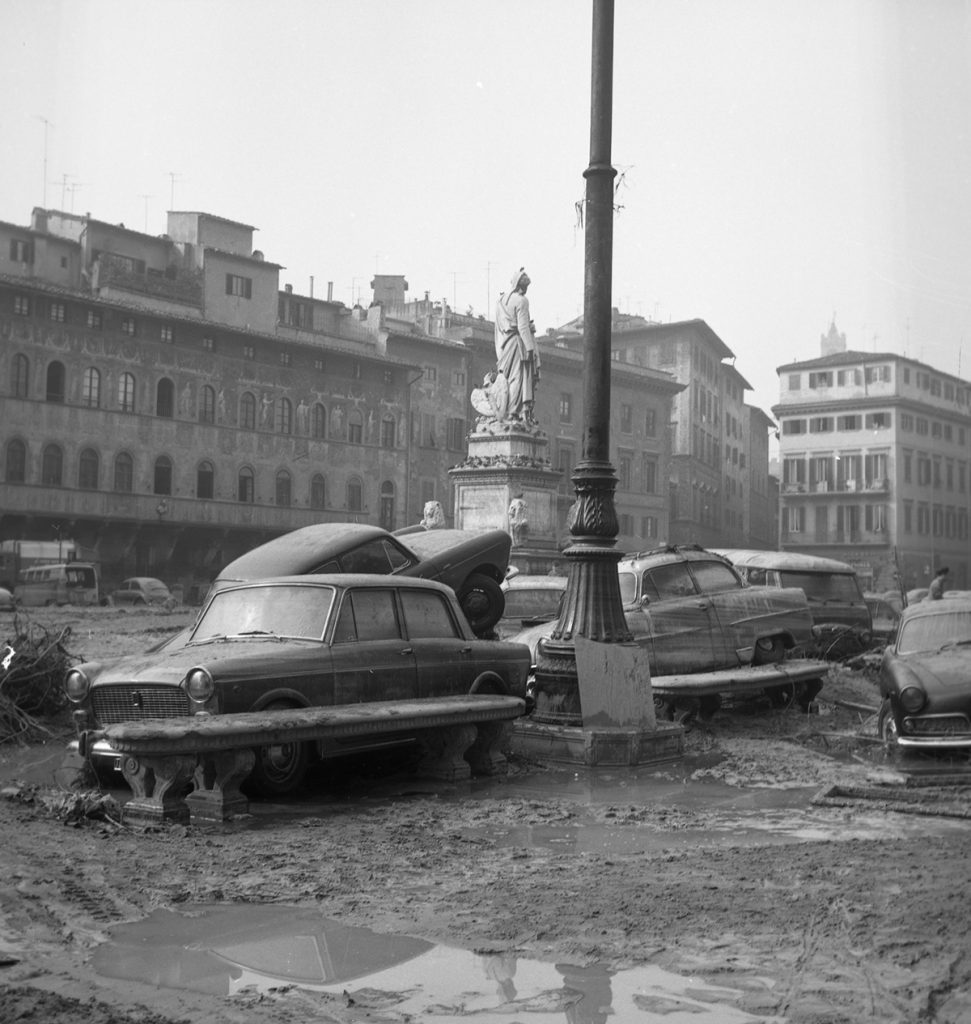
Another interesting exhibit is being offered at the Bibilioteca Nazionale, or National Library, one of the hardest hit locations of the flood. With important documents collected from past centuries and sitting right along the Arno river, many important documents and works were lost. Here is where a major help by the Mud Angels took place, with volunteers lined up and trying to save the millions of books and papers covered in mud and water. The library is hosting the photo exhibit “Arno66: the Time Machine” which is a collection of 3500 photos from the days after the flood. More interesting part is the virtual tour created that will let visitors wear a helmet and immerse themselves in the flood waters, in a manner of speaking. You can get an idea of the richness of the exhibit and tour through the official website here: http://arno66ar.it/. To actually be able to take the virtual tour, you need to book a spot. You can call 334-6606716 or send an email to bnf-fi.urp@beniculturali.it. The tour lasts about an hour and can be booked by phone between October 29 and November 25th between 10am-1pm and 2-5pm between Monday and Saturday. Tours will run at these times: November 4: 10:30am and 4pm, November 5 and 6: 10am, 12pm, 3pm and 5pm. From November 7-26 (excluding Sundays): tours will be offered Monday-Friday at 10,30am and 4pm, on Saturdays at 11:30am.
“D’Acqua e Fango: From Water and Mud” – Casa di Bargellini (Florence)
The Case della Memoria, or Houses of Memory association, have organized an exhibit at the home of Piero Bargellini, mayor of Florence during the 1966 flood, located on Via delle Pinzochere, 3, just off Piazza Santa Croce. The exhibit called “Gli Alluvionati ed il loro Sindaco” presents for the very first time letters, documents, photographs, testimonies received and written by the then Florence mayor Bargellini. The main protagonist of the exhibit are the Florentine citizens who sent letters to the mayor asking for help by describing their family’s situation after the flood. The exhibit runs until November 13.
Events, exhibits and more beyond Florence
As you travel around Tuscany this fall, you will likely also find temporary exhibits in smaller towns showcasing photographs and videos of how the flood affected Florence and beyond, given the Arno flooded the plains along its course all the way down to Pisa. For example, a photo exhibit of photos by Roberto Germogli will be taking place in San Donato in Poggio’s Palazzo Malaspina until November 27. More details here.
We will continue updating this post over the next few days as more interesting events and exhibits come to our attention!
For more details on all of the events, exhibits and conferences being held across Tuscany, you should go to the official website for the commemoration of the 1966 flood here http://toscana.firenze2016.it/